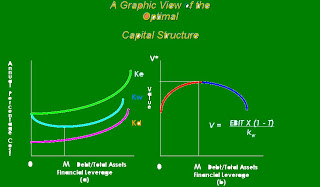EBIT/EPS Analysis
EBIT - Earnings Before Interest and Taxes. Accountants like to use the term Net Operating Income for this income statement item, but finance people usually refer to it as EBIT. Either way, on an income statement, it is the amount of income that a company has after subtracting operating expenses from sales (hence the term net operating income). Another way of looking at it is that this is the income that the company has before subtracting interest and taxes (hence, EBIT).
EAT - Earnings After Taxes. Accountants call this Net Income or Net Profit After Taxes, but finance people usually refer to it as EAT.
EPS - Earnings Per Share. This is the amount of income that the common stockholders are entitled to receive (per share of stock owned). This income may be paid out in the form of dividends, retained and reinvested by the company, or a combination of both.
The Analysis
I need to raise additional money by issuing either debt, preferred stock, or common stock. Which alternative will allow me to have the highest earnings per share?
This question calls for an EBIT/EPS analysis. Simply put, this simply means that we will calculate what our earnings per share will be at various levels of sales (and EBIT).
Actually, it isn't necessary to start with sales. Since a company's EBIT, or net operating income, isn't affected by how the company is financed, we can skip down the income statement to the EBIT line and begin there. In other words, we assume a certain level of sales, calculate our estimated EBIT at that level, and then calculate what our EPS will be for each alternative form of financing (debt, preferred stock, and common stock).
An Illustration
For example, let's assume that the company:
1. is currently financed entirely with common stock (i.e., no debt and no preferred stock). The firm has 2,000 shares of common stock outstanding.
2. currently pays no common stock dividend; all earnings are retained and reinvested into the company.
3. needs to raise Rs.50,000 in new money. As financial manager, you want to know which financing alternative should be used.
4. is in the 35% tax bracket.
To raise the Rs50,000, you are considering three alternatives:
1. common stock - The company can sell additional shares at the current price of Rs.50 per share. This means that 1,000 new shares of common stock will need be to be sold (Rs50,000/Rs.50 per share).
2. preferred stock - The dividend yield on preferred stock will have to be 7.3% of the amount of money raised. (The preferred can be sold for Rs.40 per share.) The number of shares of common stock will remain unchanged.
3. debt - The interest rate on any new debt will be 4% per year. The number of shares of common stock will remain unchanged.
Let's pick a beginning level for EBIT of RS.10,000. We can then calculate what the earnings per share will be for each financing alternative.
The above table shows us the earnings per share at an EBIT level of Rs.10,000. If sales are sufficiently high to give us an EBIT level of Rs.10,000, then our EPS will be highest by issuing debt, common stock yields the next highest EPS, and the preferred stock alternative results in the lowest level of EPS.
However, we would eventually like to draw a graph of the EPS over a range of sales and EBIT. This will allow us to understand the relationship between sales and EPS more fully. As sales (and EBIT) increase, what will happen to earnings per share?
This is easily answered - we just repeat the above table for a different level of EBIT. Let's assume that we don't think that our company's EBIT will fall below 2,000, so we can reproduce the table for that level of EBIT. If we think that the highest that EBIT will be for the next few years is Rs.30,000, then we might choose that level also. While we're at it, let's throw in an EBIT of Rs.20,000 also. In other words, we will construct the table for four values of
EBIT: Rs.2,000, Rs.10,000, Rs.20,000 and Rs.30,000.
Relationships
Notice the following points:
1. The preferred stock line is parallel to the debt line and lies below the debt line. This will always be the case because debt has two distinct advantages over preferred stock:
a. interest on the debt is tax-deductible and preferred stock dividends are not tax-deductible, and
b. debt is the cheaper form of financing (i.e., the interest rate is less than the preferred dividend yield) because it enjoys greater protection in the event of default).
This means that the EPS will always be higher under debt financing than under preferred stock financing. Since both options pay a fixed rate (e.g., 4% and 7.3%), they offer similar effects of leverage - leading to the parallel lines above. Preferred stock may offset this quantitative advantage with some qualitative ones (less restrictive provisions, etc.), but debt financing will always offer the higher earnings per share - a big advantage.
2. Since common stock financing offers a smaller degree of leverage, the slope of the common stock line is lower than the other two lines. This leads to two "crossover points" where the common stock line crosses the other two lines. These are indifference points.
· At an EBIT level of Rs.6, 000, you would be indifferent between common stock financing and debt financing. Both will give you the same EPS (of Rs.1.30 per share).
· At an EBIT level of Rs.16, 800, you would be indifferent between common stock financing and preferred stock financing. Both will give you the same EPS (of Rs.3.64 per share).







